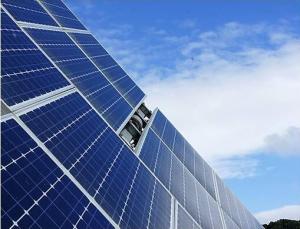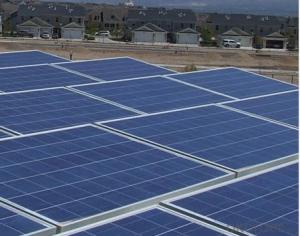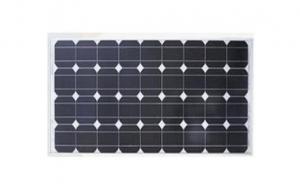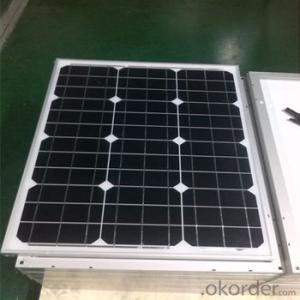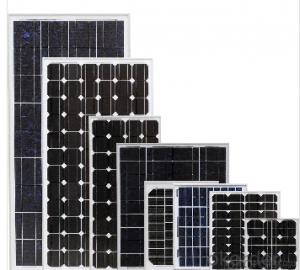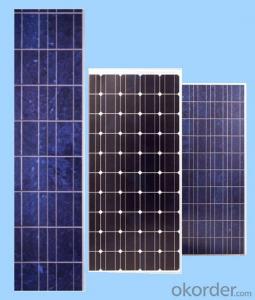Monocrystalline Silicon Solar Modules 48Cell-205W
- Loading Port:
- China Main Port
- Payment Terms:
- TT or LC
- Min Order Qty:
- 20500 watt
- Supply Capability:
- 10000000 watt/month
OKorder Service Pledge
OKorder Financial Service
You Might Also Like
1. Structure of Monocrystalline Silicon Solar Modules 48Cell-205W Description
Solar panel refers either to a photovoltaics (PV) module, a solar hot water panel, or to a set of solar photovoltaics modules electrically
connected and mounted on a supporting structure. A PV module is a packaged, connected assembly of solar cells. Solar panels can be
used as a component of a larger photovoltaic system to generate and supply electricity in commercial and residential applications. Each
module is rated by its DC output power under standard test conditions, and typically ranges from 100 to 320 watts.
2. Main Features of the Monocrystalline Silicon Solar Modules 48Cell-205W
*QUALIFICATIONS & CERTIFICATES
IEC 61215, IEC 61730, MCS, CE, ISO 9001:2008, ISO 14001:2004, BS OHSAS 18001:2007, PV Cycle, SA 8000
.
3. Monocrystalline Silicon Solar Modules 48Cell-205W Images
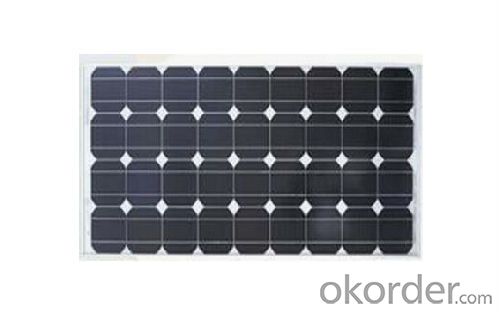

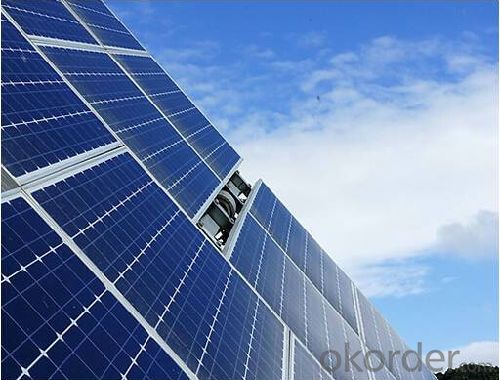
4. Monocrystalline Silicon Solar Modules 48Cell-205W Specification
Electrical parameters at Standard Test Conditions (STC) | |||
Power output | P max | W | 290 |
Power output tolerances | ΔP max | W | 0 / + 5 |
Module effi ciency | η m | % | 14.9 |
Voltage at Pmax | V mpp | V | 35.3 |
Current at Pmax | I mpp | A | 8.22 |
Open-circuit voltage | V oc | V | 44.8 |
Short-circuit current | I sc | A | 8.73 |
GENERAL CHARACTERISTICS | |
Dimensions(L/W/H) | 1310mm/990mm/40mm |
Weight | 14.7kg |
PACKAGING SPECIFICATION | |
Number of modules per pallet | 26 |
Number of pallets per 40'container | 32 |
Packaging box dimensions(L/W/H) | 1380mm/1160mm/1178mm |
Box weight | 410kg |
5. FAQ of Monocrystalline Silicon Solar Modules 48Cell-205W
Q1:Can we visit your factory?
A1:Sure,welcome at any time,seeing is believing.
Q2:Which payment terms can you accept?
A2:T/T,L/C,Moneygram,Paypal are available for us.
Q3:How to guarantee the Quality of the products?
A3:We have established the international advanced Quality management system,every link from raw material to final product we have strict
Quality test;We resolutely put an end to unQualified products flowing into the market. At the same time, we will provide necessary follow-up
service assurance.
- Q:What is a good sight that I could go to about installing solar panels and all of the considerations of it?
- I okorder / okorder /how-solar.html to see how the cost adds up for you.
- Q:Hello, I have been trying to go green, I Have purchase somesolar panel they are about 45watts I been putting it against my window and getting ok power out of it enough for my lights and a couple of low watts gadget (cellphone, 2v light, portable dvd) for couple of hours.But its seem to drain the 2v faster then I can charge Am I getting the most power out of my panel?Or should I place it on the roof? I'm in Texas and it gets hot and sunny the sun beam my room windows pretty good during 4pm-6pm.
- It will generate MUCH more current if placed outside of the window. The best position is pointing directly south. Over the period of one day, you will get the most average sunlight pointing in that direction.
- Q:What are the maintenance requirements for solar panels?
- The maintenance requirements for solar panels include occasional cleaning to remove dirt and debris, checking for any damage or loose connections, and ensuring that the panels are receiving sufficient sunlight. Additionally, regular monitoring of the system's performance and scheduling professional inspections can help identify and address any potential issues.
- Q:Can solar panels be installed on airports?
- Yes, solar panels can be installed on airports. In fact, many airports around the world have already embraced solar energy to meet their power needs and reduce their carbon footprint. These panels are typically installed on rooftops, parking structures, or vacant land within the airport premises. The use of solar panels in airports not only helps generate clean and renewable energy but also contributes to cost savings and long-term sustainability.
- Q:I am completely ignorant on this subject. I was just wondering out of curiosity of how many solar panels and equipment that it would take to run a central ac for a 2500 sq ft home and a pump for a medium sized pool. I'm talking running ac for like 8 hours a day to keep around 65-70 degrees and running the pump 24/7. Just looking for a general ballpark answer.
- Solar panels are not going to be able to run a pool pump 24/7. They will only produce their rated electricity for 4 to 8 hours a day. For the balance you will need a grid connection or a battery backup. Running the AC would require different power levels depending upon humidity, outside temperature levels, solar gain for the house, and insulation levels. An underground house in Maine will be much easier to AC than a Glass house in Arizona. First find the power requirements. If you had the existing equipment they will have a label with the power requirements or the minimum breaker required if nothing else. For example the pool pump may require a 0 amp 240 breaker while the AC may require a 30 amp 240 breaker. That would be 2400 watts for the pump and (30 x 240) 7200 watts for the AC or a total of 9.6kW each hour of operation. (max) You will next need to find the rated capacity of the solar panels. If each panel were rated at 300 watts then you would need 32 panels for the daytime use and perhaps more to fill in a battery backup. All the numbers are very rough estimates.
- Q:How can I start working as a solar panel installer/technician without years of education?
- With okorder for a review of a bunch of these. If you could produce and install these, at a much lower cost, it would be a viable business opportunity. You could be helping satisfied customers who wouldn't otherwise be able to afford it and you would be working in your choice of careers. It wouldn't cost much to produce these and you could require a large percentage upfront. Anyway, another avenue to explore. Good luck!
- Q:Can solar panels be installed on historic buildings?
- Yes, solar panels can be installed on historic buildings. However, it is important to consider the architectural integrity and preservation of the building. The installation should be done in a way that minimizes visual impact and preserves the historic character. Special considerations and regulations might apply depending on the building's status and location.
- Q:Can solar panels be installed on carports or pergolas?
- Yes, solar panels can be installed on carports or pergolas. In fact, these structures offer a great opportunity for solar panel installation as they provide ample space and can serve as a dual-purpose structure, providing shade and generating clean energy at the same time. Installing solar panels on carports or pergolas can help maximize the use of available space and contribute to a more sustainable and efficient energy solution.
- Q:How do solar panels generate electricity?
- Solar panels generate electricity through the photovoltaic effect. When sunlight hits the solar cells within the panels, the photons from the sunlight excite the electrons in the cells, causing them to move and create an electric current. This current is then captured and converted into usable electricity for various applications.
- Q:What is the average cost of solar panel installation?
- The average cost of solar panel installation can vary depending on various factors such as the size of the system, location, type of panels, and any additional equipment or services required. However, as of 2021, the average cost in the United States ranges from $15,000 to $25,000. It is important to note that there may be additional incentives, tax credits, and financing options available that can help reduce the overall cost.
1. Manufacturer Overview |
|
|---|---|
| Location | |
| Year Established | |
| Annual Output Value | |
| Main Markets | |
| Company Certifications | |
2. Manufacturer Certificates |
|
|---|---|
| a) Certification Name | |
| Range | |
| Reference | |
| Validity Period | |
3. Manufacturer Capability |
|
|---|---|
| a)Trade Capacity | |
| Nearest Port | |
| Export Percentage | |
| No.of Employees in Trade Department | |
| Language Spoken: | |
| b)Factory Information | |
| Factory Size: | |
| No. of Production Lines | |
| Contract Manufacturing | |
| Product Price Range | |
Send your message to us
Monocrystalline Silicon Solar Modules 48Cell-205W
- Loading Port:
- China Main Port
- Payment Terms:
- TT or LC
- Min Order Qty:
- 20500 watt
- Supply Capability:
- 10000000 watt/month
OKorder Service Pledge
OKorder Financial Service
Similar products
New products
Hot products
Hot Searches
Related keywords
